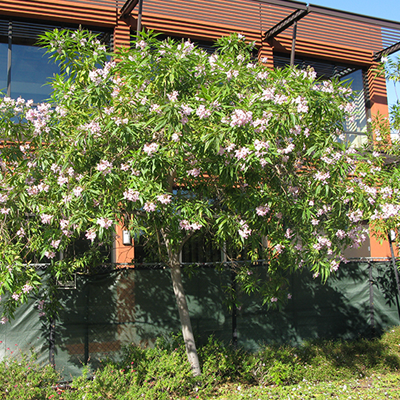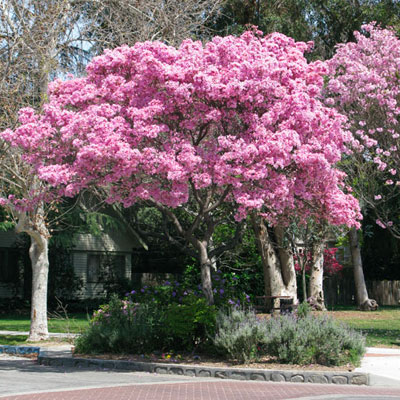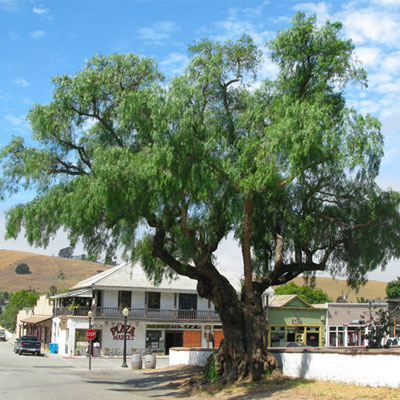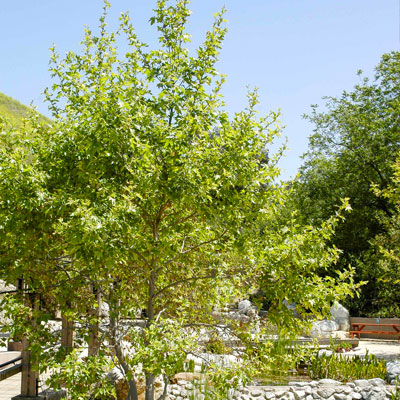Learn About Tree Species
In our campaign to combat the Urban Heat Island effect and increase the urban canopy of Altadena and surroundings, Altadena Heritage is offering another free tree give away.
Understanding the tree descriptions in this list
- Evergreen, semi-deciduous (partially or briefly deciduous), and deciduous trees are indicated by E, S, and D, respectively.
- Sizes at maturity are indicated as Height x Width, for example, 20-25’ x 15’ means that, generally, the mature size of the tree will be between 20 and 25 feet tall and 15 feet wide.
- Many factors can influence the final size of the tree, including shade, root run, and geographical location. The sizes given in SelecTree are not always accurate for Southern California. We have tried to give you sizes you can expect in this area.
Selecting a Tree
The list below presents a brief description of each tree. You may read more about each tree, including growth rate, sun or shade preference, and much more, by clicking on its botanical name.
The link will take you to that tree’s entry in SelecTree, a database maintained by the Urban Forest Ecosystems Institute at Cal Poly State University, San Luis Obispo.
Small Trees – Up to 25 Feet Tall

A hybrid between Chilopsis linearis and Catalpa bignonoide. C. linearis (Desert Willow) is native to Western North America. Catalpa is native to the southeastern United States. Deciduous, 25-35’ x 30’. Chitalpa generally remains below 25’ in height. Fast growing (36”/year). Makes showy flowers over a long bloom period. Requires good drainage. Susceptible to root rot. Blooms best in full sun, when it receives moderate moisture. It becomes taller in half shade. Root damage potential is low. Wildlife uses the fruit. This is a small flowering accent tree, especially useful in riparian or native garden settings, usually multi trunked or low-branching. We will be offering standard trees. Caution: this tree is not suitable as a patio tree, as it continually drops a lot of litter – dried flowers, leaves, and in the fall, fruits.
Medium Trees – 25 to 40 Feet Tall

Handroanthus heptaphyllus (Tabebuia heptaphyllus) Pink Trumpet Tree. Semi-deciduous, 20-30’ x 15- 25’. Moderately low shading, well-drained soil, medium water use when established, full sun, and 12″-24″ growth per year. Established trees can get by on infrequent deep irrigation. Spectacular when in full bloom with showy pink or purple flowers in Winter or Spring that attract hummingbirds. Does well in lawns with good drainage.

Schinus molle California Pepper, Peruvian Pepper. Evergreen, 25-50’ x 25-40’. Gives moderate to dense shading, low water use when established, full sun to partial shade and 12″-24″ growth per year. The fragrant flower and fruit attracts bees. Wildlife uses the fruit. Root damage potential is high. Old trees will become hollow.

Koelreuteria bipinnata Chinese Flame Tree. 40’ x 15-30’. Moderate growth rate (12-24”/yr). Yellow flowers in fall or summer. Fruit is in the form of large orange, red, or rose lantern-like seed pods. Medium water, low root damage potential. K. panniculata (40’ x 25 – 40’) may be substituted, depending on availability.
Large Trees – Over 40 Feet Tall

Platanus Racemosa Western sycamore. Native to California. Deciduous, 80’ x 20-50’. Fast growing (~36“/year). This large tree is known for its striking, mottled bark that peels away in patches, revealing a smooth, creamy underlayer. Its broad, spreading canopy provides ample shade. The leaves are large, lobed, and turn a beautiful golden hue in the fall. It produces small, round seed balls that hang in clusters and add visual interest throughout the year. Its resilience to pollution and ability to thrive in various soil types make it a versatile addition to urban environments. Expect some litter: Bark, dry fruit, leaves, twigs.
Oak, Quercus species, will not be offered this year, but you can get free seedlings from Grow Monrovia at their garden any Saturday from 7-11 am.
